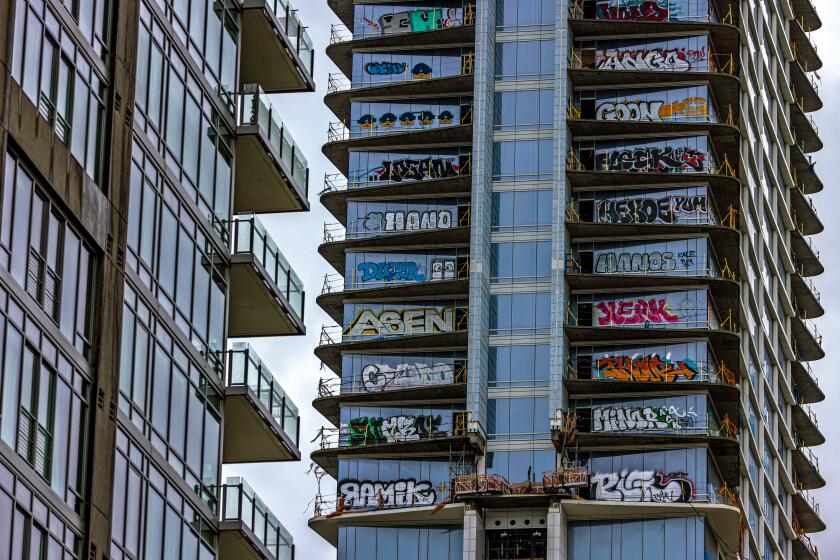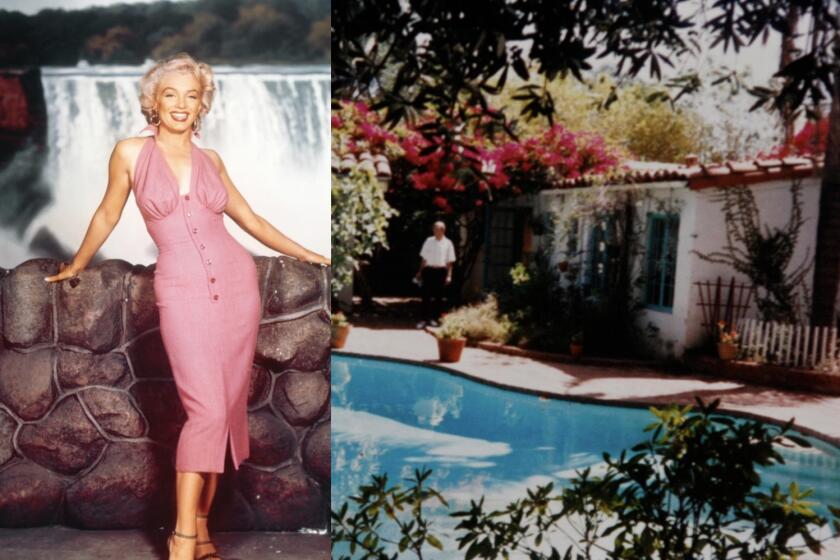First-Time Buyers Like Low Prices, Accessibility : Sepulveda: Freeway location and prices help boost community in transition as it overcomes high-crime reputation.
Two years ago Phillip Cole found himself in the same quandary that many Southern Californians face--he was looking for an affordable first home. He solved his problem in Sepulveda, in the northern San Fernando Valley.
In June, 1989, Cole purchased a new two-bedroom, 1 1/2-bath townhome for $120,000. The 1,300-square-foot home also has a three-car attached garage.
“The same unit in a suburb such as Glendale, Pasadena or Burbank would have been close to $50,000 more for the same type of unit,” Cole said. “As a first-time buyer, you go where you can afford to go.”
The community’s location was equally important to Cole. As a salesman of contract services for rental uniforms and related garments, his territory encompasses all of Los Angeles County.
“I’m literally two or three minutes from the major freeway systems--the San Diego Freeway, the Golden State Freeway and the 118 (Freeway),” he said. “Commuting to all areas from Sepulveda is extremely easy.”
Sepulveda’s location also attracted the Berlins 10 years ago. Patrice, a homemaker, and Mike, a photography director, bought their 2,200-square-foot home in 1981 for $225,000. The home, on a one-acre lot, has three bedrooms, two baths, a barn, a summer house and a garage big enough for eight cars.
“I don’t know if people really realize how central this area is,” Patrice Berlin said. “I don’t think there’s any other place in the Valley that’s as close to all these freeways.”
Berlin is pleased with the changes she has seen in Sepulveda. “We’ve seen significant improvement in the last few years,” she said. “The developers have come in and torn down the older homes and put in new developments.”
Cape West and Avante are two of several single-family home projects being developed by Urban RealCorp., one of the most active builders in the area. Others are MWH Development, West Wilshire Development and Concept Developers.
Both Urban RealCorp. projects feature single-family detached homes in gated communities. The homes range in size from 1,600 to 1,900 square feet, have three or four bedrooms, 2 1/2 or three baths, attached two-car garages and range in price from $239,000 to $287,000.
Jeff Cronrod, president of Urban RealCorp., describes Sepulveda, with an estimated population of 30,320, as a community in transition.
“I think the area is pretty good right now, and I think we’ll get even better in the future,” he said. “We (Urban RealCorp.) are committed to the area and have more money invested in Sepulveda than in any other single place.”
Tom Henry, assistant to Los Angeles City Councilman Joel Wachs, agreed that Sepulveda is a community in transition when he described the councilman’s goals for the area:
“We want to revitalize the deteriorating areas and preserve areas that need to be preserved,” he said. “We are trying to create affordable single-family housing. The area is in transition, but also preservation at the same time.”
Steve Smiley, manager of the Encino-based Meyers Group, a real estate consulting firm, said that the entire area is being rebuilt.
“There’s a lot of redevelopment and you’re going to be able to find a lot of good deals for attached and detached housing,” he said.
According to Smiley, in March the median price for a new single-family detached home with a median square footage of 1,850 was $272,950. The median price for a new single-family attached home with a median square footage of 1,160 was $142,950.
Affordable housing and its central location should make Sepulveda a “hot spot,” but the area has had to overcome the stigma of being labeled a high crime community with a booming drug trade.
“I don’t like the adverse publicity that Sepulveda has received in the past in regard to ‘C’ street,” Patrice Berlin said. “It has had no negative effect on us, other than giving Sepulveda a bad name.”
“C” street is actually Columbus Street, but in the past, the amount of drug traffic on the street led to its unofficially being called “C” street.
“The ‘C’ didn’t stand for Columbus,” Henry said, “but for cocaine. It was a drive-through drug store. Even driving a county car, we would be approached.”
“We stopped traffic from going through the street and limited access,” he said. “Some of the residents feared the drug traffic would just move to another street, but it didn’t happen--the drug traffic dissipated. You now see people out walking their dogs again.”
The community’s tarnished image recently led a group of Sepulveda residents living west of the San Diego Freeway to seek approval from the City of Los Angeles to form a new community called North Hills. The city recognized the new community on May 13, but the U.S. Postal Service has not yet followed suit.
Last November, the Espinoza family--Esther, Michael, Kelsea and Allana--moved to Sepulveda from West Los Angeles, even though they had heard from well-meaning friends that they didn’t want to move to “that area.”
“I was a bit apprehensive at the beginning,” Esther Espinoza said, “but you have to be realistic. Moving to Sepulveda allowed us to buy a nice home without having to commute farther.
“You’re just outside the city, yet you’re in an area where you can still commute to different areas--the beach, downtown or Westwood. I think that’s a big plus and very important to families, primarily those who have children they want to spend more time with.”
The Espinozas purchased a new 2,100-square-foot two-story home with three bedrooms, 2 1/2 baths and an attached two-car garage for about $237,000.
Longtime Sepulveda residents, Kim and Andy Van Dyk moved to their current home in 1981. They bought their 2,000-square-foot, three-bedroom, 2 1/2-bath home with an attached two-car garage for $129,950.
“The neighborhood has everything I need,” said Kim Van Dyk, a real estate sales agent. “We have great shopping, banks and restaurants. I like shopping within walking distance of my home and could do without a car for a day or two if I had to.”
Steve Owen, president of the San Fernando Valley Board of Realtors, said, “The median sale price of an existing single-family home in Sepulveda sold during March was $207,000. Currently there are 256 active properties on the market.”
Last year, part of the community’s efforts to clean up their image included the formation of Graffiti Busters. Associated with the Greater Van Nuys Area Chamber of Commerce, the group sponsored three beautification days last year.
“We had several hundred people out on the first one,” Officer John Girard said. Girard, assigned to the Devonshire station of the Los Angeles Police Department, is active in community relations and a member of the Sepulveda Community Council.
“We all have a stake in the community, and we’re committed to making a difference in the area,” Girard said. “We can slow down crime. I think a good measurement is in results--it’s more than just talking about the crime rate, it’s the people’s peace of mind that’s important.”
“A lot of areas don’t have this kind of community involvement,” he added. “This community wants change, and the people want to make it work. Churches, residents and apartment building owners are getting involved with community watch programs.”
The community council includes homeowners, landlords and professionals working within the community and meets the second Tuesday of every month. Interested parties may call Girard at (818) 908-4011 for additional information.
While some communities discourage new development, most Sepulveda residents welcome the home-building activity.
“I think the builders have been shoveling out a lot of the crime elements by just continuing to build new units,” Phillip Cole said.
New resident Esther Espinoza agrees. “You have these new communities going up in the area, and it’s pretty much going to be pushing the crime element out in the near future,” she said.
Longtime resident Berlin added: “Looking out your window at these new homes is really an improvement. They (the developers) have brought in a lot of new families, and it’s really turned into a nice community as far as we’re concerned.”
Sepulveda’s initial development may be attributed to the arrival of the railroad in the 1870s. During the early 1900s Western expansion created increased demand for homesteads and the area grew. Much of the original development was on one-acre plots where the residents planted vegetable gardens, fruit trees and ran chicken and rabbit ranches.
Mission Acres was the first name of the community, but the citizens voted to change the name to Sepulveda in 1927 to honor Francisco Sepulveda, who settled in Los Angeles in 1815 and became acting mayor in 1825.
The population continued to grow, with the largest jump occurring during the 1930s through the 1950s.
Gail Bluestone and housemate Dianne Montagna plan to complete a move to Sepulveda this summer. Bluestone, a counselor for the Los Angeles Unified School District, and Montagna, a manufacturing scheduling coordinator, recently pooled their resources to buy a new home.
“We found low prices on brand new housing,” said Bluestone. “I think that’s going to be good, because with new people, it’s like starting over again with a new community.”
The “shared-wall” home that Bluestone and Montagna bought has three bedrooms, 2 1/2 baths, an attached two-car garage and about 2,100 square feet of living space. It was priced in the low $200,000s.
Both women were aware of the community’s less-than-perfect reputation, but Bluestone said: “I know that it has been marred by graffiti, and it’s been marred by people who haven’t taken care of the area. It’s known as a drug area, but the police seem to have it under wraps.”
“As they clean up the area, there’s a lot of new construction,” she said. . . . It’s going to bring a different element of people into the area.
“Sepulveda is just like any other town. We’re living in Los Angeles, and in any city, no matter which part of the country you go to, there are problems, and those are society’s problems.”
At a Glance Population
1990 estimate30,318
1980-90 change+28.2%
Median age30.6 years
Annual income
Per capita15,987
Median household39,241
Household distribution
Less than $25,00029.3%
$25,000 - $35,00014.2%
$35,000 - $50,00019.7%
$50,000 - $75,00023.3%
$75,000 + 13.5%



